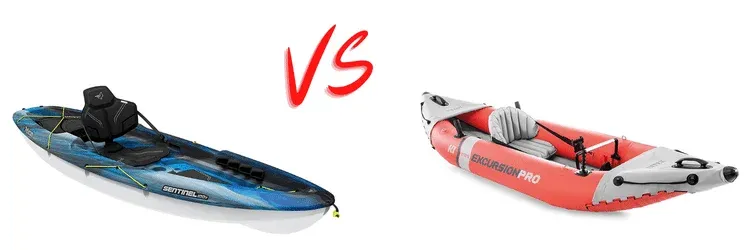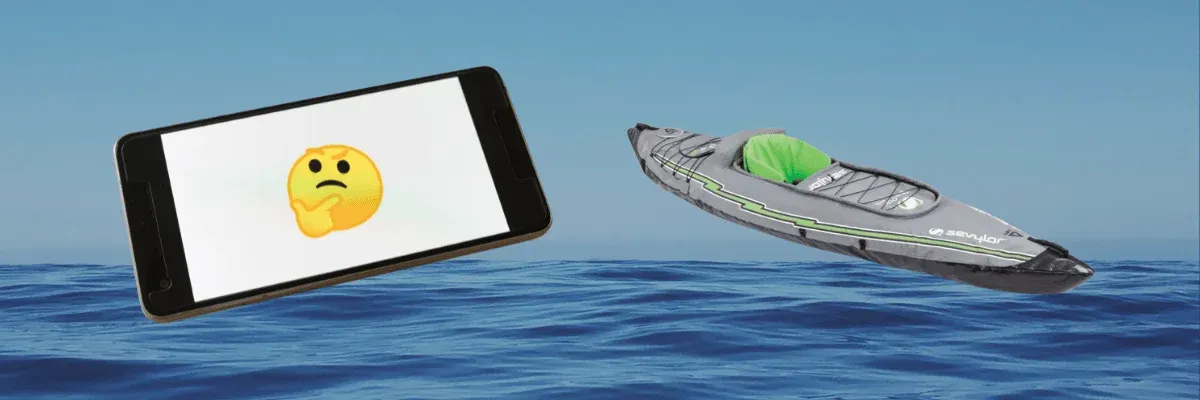Kayaking is a thrilling water sport that has gained immense popularity over the years. Whether you're a seasoned paddler or a beginner, the choice between an inflatable kayak and a hard shell kayak can be a tough one. This comprehensive guide will delve into the nitty-gritty of both kayak types, helping you make an informed decision.
Key Takeaways:
- Understand the fundamental differences between inflatable and hardshell kayaks.
- Discover the practicality and performance of inflatable kayaks in various water conditions.
- Learn about the cost, storage, and transportation benefits of inflatable kayaks compared to their hardshell counterparts.


What Defines an Inflatable Kayak?
Inflatable kayaks are designed with high-quality inflatable materials like durable rubber, synthetic rubber, or heavy-duty construction plastic polymers. They are known for their lightweight nature and can be packed into a duffle bag or carry bag, making them highly portable.
The Hard Shell Kayak Explained
Hard shell kayaks, on the other hand, are built with rigid materials such as fiberglass, carbon fiber, or other composite materials. They offer a rigid structure and are typically more durable in rough waters, but lack the storage space convenience of their inflatable counterparts.
Performance on the Water
When it comes to performance, hardshell kayaks are often seen as the more reliable option. They have a rigid frame that cuts through water efficiently, making them suitable for activities like whitewater kayaking and sea touring.
Inflatable Kayaks: A Question of Durability
Inflatable kayaks have come a long way in terms of durability. Thanks to advancements like drop stitch construction and high-quality materials, most inflatable kayaks can withstand a good deal of wear and tear.
Transportation and Storage Space
One of the biggest advantages of inflatable kayaks is their ease of transportation. Without the need for a roof rack, an inflatable kayak can be transported in the trunk of a car and stored in limited storage space at home.
The Cost Factor
Generally speaking, inflatable kayaks offer a lower price tag compared to hardshell kayaks. This makes them an attractive option for those who are new to the sport or are not ready to invest heavily in their first kayak.
Suitability for Different Water Conditions
While hardshell kayaks are typically preferred for rough waters, most inflatables are designed to perform well in calm waters. However, some high-end inflatable models are also capable of handling more challenging conditions.
Weight Capacity Considerations
Inflatable kayaks often boast a higher weight capacity than hardshell kayaks. This is an important factor to consider if you plan on carrying additional gear or a companion.
The Verdict on Fishing Kayaks
Fishing kayaks require stability and space for equipment. While hardshell fishing kayaks are prevalent, inflatable fishing kayaks have also gained popularity due to their portability and improved stability features.
Maintenance and Repair
Inflatable kayaks tend to come with their own repair kit, making them easier to maintain. Hardshell kayaks, while less prone to punctures, can be more challenging to repair if damaged.
The Environmental Impact
Both inflatable and hardshell kayaks have an environmental footprint, but the manufacturing process and materials used for inflatable kayaks can sometimes be less harmful to the environment.
The Learning Curve
For beginners, inflatable kayaks can be more forgiving and easier to maneuver. Hardshell kayaks require a bit more skill to handle, especially in challenging water conditions.
The Comfort Factor
Inflatable kayaks often feature inflatable seats, which can be more comfortable during long paddling sessions. Hard shells may have more ergonomic seating but can be less forgiving on the body.
The Safety Aspect
Safety is paramount in kayaking, and both inflatable and hardshell kayaks must meet certain safety standards. Always look for models that are approved by the Coast Guard or similar authorities.
The Longevity of Your Kayak
When properly cared for, both inflatable and hardshell kayaks can last for many years. The longevity of your kayak will largely depend on the quality of materials and construction.
The Aesthetic Appeal
While functionality is key, the aesthetic appeal of a kayak can also be a deciding factor. Hardshell kayaks often have a sleeker look, while inflatable kayaks have a more utilitarian appearance.
The Social Aspect
Joining a community of other kayakers can enhance your paddling experience. Whether you choose an inflatable or hardshell kayak, there's a community for every kayak type.
The Resale Value
If you're considering the resale value of your kayak, hardshell kayaks tend to retain their value better than inflatable ones. However, a well-maintained inflatable kayak can still fetch a reasonable price.
The Adventure Factor
For those who crave adventure, both inflatable and hardshell kayaks can provide thrilling experiences. It ultimately comes down to personal preference and the type of adventures you're seeking.
The Innovation in Kayak Design
Innovation in kayak design is ongoing, with new materials and technologies improving the performance of both inflatable and hardshell kayaks. Keep an eye out for the latest advancements.
The Influence of Brand Reputation
Brand reputation can play a significant role in the quality and performance of a kayak. Researching and choosing a reputable brand can lead to a more satisfactory purchase.
The Impact of Reviews and Testimonials
Reading reviews and testimonials from other kayakers can provide valuable insights into the real-world performance of a kayak. Take the time to research and read about others' experiences.
The Role of Warranty and Customer Service
A good warranty and responsive customer service can add value to your kayak purchase. Consider the level of support offered by the manufacturer before making your decision.

The Versatility of Inflatable Kayaks
When considering whether are inflatable kayaks as good as hard kayaks, versatility is a key factor. Inflatable kayaks offer a level of flexibility that their hardshell counterparts struggle to match. For instance, most inflatable kayaks can easily transition from a serene lake to a flowing river, thanks to their lightweight nature and durable rubber construction. They can be equipped with inflatable seats that enhance comfort during long paddles, and their ability to deflate to the size of a duffle bag means you can take them on adventures that would be inaccessible to a rigid frame kayak.
Moreover, inflatable kayaks tend to have a higher weight capacity relative to their size, which is a big deal for kayakers who love to bring along gear or a furry friend. The drop stitch construction used in high-quality inflatable kayaks ensures they maintain a rigid structure when inflated, rivaling the performance of hard shells in many water conditions. Whether you're a seasoned paddler or a newcomer, the versatility of an inflatable kayak makes it a compelling choice for a range of activities, from fishing to whitewater kayaking.
The Role of Materials in Kayak Durability
When comparing inflatable kayaks to hard shell kayaks, the materials used in their construction play a pivotal role in their durability. Inflatable kayaks are often made from heavy-duty PVC or durable rubber with drop stitch construction that allows them to withstand bumps and scrapes. This technology involves connecting two pieces of fabric with thousands of fine threads, creating a rigid structure when inflated. On the other hand, hardshell kayaks are typically crafted from composite materials like fiberglass or carbon fiber, offering a solid and puncture-resistant surface.
However, the durable materials used in high quality inflatable kayaks have significantly closed the gap in durability between inflatable and hardshell kayaks. Most inflatables now come with reinforced bottoms and heavy duty construction that can brave rough waters and contact with rocks. While hard shells may still have the edge in extreme conditions, inflatable yaks have proven to be robust companions for seasoned paddlers facing diverse environments. The key is proper maintenance; carrying a repair kit can extend the life of an inflatable kayak, just as regular care is essential for hardshell kayaks.
Storage and Portability: Inflatable vs Hardshell
One of the most significant advantages of inflatable kayaks is their ease of storage and transport. Without the need for a roof rack, an inflatable kayak can be deflated, rolled up, and tucked away into a duffel bag or carry bag, making them ideal for those with limited storage space. This lightweight nature also means that transporting your kayak to remote locations is a breeze, often simply involving a short walk with the kayak in a backpack. This convenience is a game-changer for urban dwellers or those who enjoy spontaneous paddling adventures.
Conversely, hardshell kayaks require more thought when it comes to transportation. Typically, a roof rack is necessary to secure a hard shell kayak to a vehicle, and the rigid frame means they take up a significant amount of space at home. However, for serious kayakers with the appropriate storage and transport means, hardshell kayaks offer a ready-to-go option without the setup time of their inflatable counterparts. Whether the convenience of an inflatable kayak outweighs the immediacy of a hardshell kayak often comes down to personal preference and lifestyle.
The Adaptability of Hardshell Kayaks
Hardshell kayaks, on the other hand, are often praised for their performance and durability. Made from materials like plastic polymers, carbon fiber, or other composite materials, hard shell kayaks are built to withstand rough waters and provide a stable ride. They have a rigid frame that offers better control and speed, making them the preferred choice for serious kayakers who prioritize performance. Hard shells also lack storage space issues, as they often come with built-in compartments and deck rigging to secure safety gear and other essentials.
However, hardshell kayaks require a bit more commitment when it comes to transportation and storage. You'll likely need a roof rack to transport your hard shell kayak, and ample storage space at home to keep it safe when not in use. Despite these considerations, for many, the durability and performance of hardshell kayaks make them worth the investment. Whether you're into sea kayaking, touring, or racing, a hard shell kayak's adaptability in various water conditions and its long-lasting nature make it a solid purchase for dedicated paddlers.

The Decision: Inflatable or Hardshell?
Ultimately, the decision between an inflatable kayak and a hardshell kayak will depend on your specific needs, preferences, and the type of kayaking you plan to do.

Summary
Choosing between an inflatable kayak and a hard shell kayak is a decision that hinges on various factors such as performance, durability, cost, storage, and transportation. Inflatable kayaks have evolved to offer remarkable durability, portability, and a lower price tag, making them an excellent choice for beginners and those with limited storage space. Hardshell kayaks, with their rigid structure and superior performance in rough waters, remain the go-to for serious kayakers and those engaging in more aggressive paddling activities.
Inflatable kayaks are not just about convenience; they have proven their worth on the water, with some models boasting features that rival their hardshell counterparts. From fishing to whitewater adventures, there is an inflatable kayak designed to meet the needs of most paddlers. However, hardshell kayaks still hold the edge in terms of performance and longevity, especially for those who paddle frequently in challenging conditions.
When considering an inflatable vs hardshell kayak, it's essential to weigh the pros and cons of each type based on your individual kayaking style, the waters you'll be navigating, and your budget. Both types have their place in the world of kayaking, and the best choice is the one that aligns with your personal paddling goals and lifestyle.

FAQs
Can inflatable kayaks handle rough waters as well as hardshell kayaks?
While high-quality inflatable kayaks are designed to be more durable and can handle some rough waters, hardshell kayaks generally provide better performance and stability in challenging conditions due to their rigid frame and construction.
Are inflatable kayaks more affordable than hardshell kayaks?
Yes, inflatable kayaks typically come with a lower price tag, making them a more budget-friendly option for those new to kayaking or not looking to make a significant investment.
How do I decide between an inflatable and a hardshell kayak?
Consider factors such as the type of water you'll be paddling in, storage and transportation options, your budget, and how often you plan to use the kayak. Additionally, think about the weight capacity you need and whether you prioritize portability over performance.









